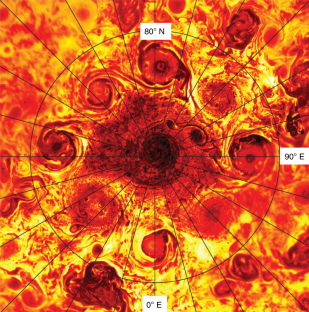気の遠くなるような巨大な渦の安定した幾何学的配置はまだ解明されておらず、新しい物理学のヒントになるかもしれません。 The stable, geometric arrangements of mind-bogglingly huge vortexes are still unexplained and may hint at new physics.
2022-09-23 ミシガン大学
惑星の最北端では、極付近に中央のサイクロンがあり、周極低緯度ではその周囲に8つのサイクロンが八角形に踊っている。南半球では、同様の5つのサイクロンが集まり、五角形の形を形成している。
カリフォルニア工科大学のアール・C・アンソニー教授が率いる研究チームは、木星の北極を取り囲む奇妙な嵐に新たな光を当て、その一つ一つがアメリカ大陸とほぼ同じ大きさであることを突き止めた。
彼らの結果は、サイクロンの反対方向に吹く風の「高気圧性リング」が「多角形パターンの安定に必要である」ことを示唆していますが、チームは、嵐に関する他の疑問が残っていると指摘している。
<関連情報>
- https://www.vice.com/en/article/88qmjb/scientists-baffled-by-perfectly-geometric-polygons-of-cyclones-on-jupiter
- https://www.nature.com/articles/s41550-022-01774-0
木星の極低気圧とその周辺における200kmまでのスケールでの渦度と発散度 Vorticity and divergence at scales down to 200 km within and around the polar cyclones of Jupiter
Andrew P. Ingersoll,Shawn P. Ewald,Federico Tosi,Alberto Adriani,Alessandro Mura,Davide Grassi,Christina Plainaki,Giuseppe Sindoni,Cheng Li,Lia Siegelman,Patrice Klein & William R. Young
Nature Astronomy Published:22 September 2022
DOI:https://doi.org/10.1038/s41550-022-01774-0

Abstract
Since 2017 the Juno spacecraft has observed a cyclone at the north pole of Jupiter surrounded by eight smaller cyclones arranged in a polygonal pattern. It is not clear why this configuration is so stable or how it is maintained. Here we use a time series of images obtained by the JIRAM mapping spectrometer on Juno to track the winds and measure the vorticity and horizontal divergence within and around the polar cyclone and two of the circumpolar ones. We find an anticyclonic ring between the polar cyclone and the surrounding cyclones, supporting the theory that such shielding is needed for the stability of the polygonal pattern. However, even at the smallest spatial scale (180 km) we do not find the expected signature of convection—a spatial correlation between divergence and anticyclonic vorticity—in contrast with a previous study using additional assumptions about the dynamics, which shows the correlation at scales from 20 to 200 km. We suggest that a smaller size, relative to atmospheric thickness, of Jupiter’s convective storms compared with Earth’s, can reconcile the two studies.



